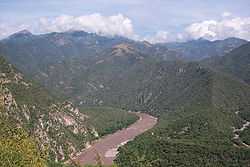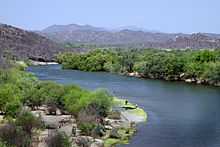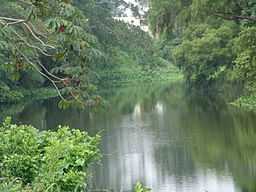List of longest rivers of Mexico

Among the longest rivers of Mexico are 26 streams of at least 250 km (160 mi). In the case of rivers such as the Colorado, the length listed in the table below is solely that of the main stem.[1] In the case of the Grijalva and Usumacinta, it is the combined lengths of two river systems that share a delta.[2] In the case of the Nazas and Aguanaval, it is the combined lengths of separate rivers that flow into the same closed basin.[2]
Three rivers in this list cross international boundaries or form them. The Colorado and the Rio Grande (Río Bravo del Norte or Río Bravo) begin in the United States and flow into Mexico, while the Usumacinta begins in Guatemala and flows into Mexico.[3][4]
The primary source for the length, watershed, and surface runoff data in the table below is the 10th edition of Statistics on Water in Mexico, published by the National Water Commission in Mexico (CONAGUA); exceptions are as noted. U.S. states and departments of Guatemala appear in italics in the "States" column. Abbreviations are as follows: "km" for "kilometre", "mi" for "mile", "s" for "second", "m" for "metre", and "ft" for "foot".
| Key | |||||
|---|---|---|---|---|---|
See also
Notes and references
- Notes
- ↑ Of the total, 1,074 km (667 mi) or about 35 percent are in the United States, and 2,034 km (1,264 mi) (about 65 percent) form a common border between Mexico and the United States.[2]
- ↑ Of the total, 225,242 km2 (86,966 sq mi) (about 48 percent) are in Mexico, and 241,697 km2 (93,320 sq mi) (about 52 percent) are in the United States.[2]
- ↑ Of the total, 5,588 x 106 m3/year (about 92 percent) come from Mexico and 502 x 106 m3/year (about 8 percent) from the United States.[2]
- ↑ Of the total, 2,140 km (1,330 mi) or about 91.5 percent are in the United States; 160 km (99 mi) (about 7 percent) are in Mexico, and 37 km (23 mi) (about 1.5 percent) form a common border between Mexico and the United States.[2]
- ↑ Of the total, 3,840 km2 (1,480 sq mi) (about 0.6 percent) are in Mexico, and 626,943 km2 (242,064 sq mi) (about 99.4 percent) are in the United States.[2]
- ↑ Of the total, 13 x 106 m3/year, about 0.07 percent, come from Mexico and 17,885 x 106 m3/year (about 99.93 percent) from the United States.[2]
- ↑ Of the total, 1,521 km (945 mi) or about 80 percent are in Mexico, and 390 km (240 mi) (about 20 percent) are in Guatemala.[2]
- ↑ Of the total, 83,553 km2 (32,260 sq mi) (about 65 percent) are in Mexico, and 44,837 km2 (17,312 sq mi) (about 35 percent) are in Guatemala.[2]
- ↑ Of the total, 71,716 x 106 m3/year (about 62 percent) come from Mexico and 43,820 x 106 m3/year (about 38 percent) from Guatemala.[2]
- References
- ↑ Kammerer, J.C. (September 1, 2005). "Largest Rivers in the United States". United States Geological Survey. Retrieved July 1, 2011.
- ↑ 2.0 2.1 2.2 2.3 2.4 2.5 2.6 2.7 2.8 2.9 2.10 Ministry of Environment and Natural Resources, ed. (June 2010). Statistics on Water in Mexico (PDF) (10th ed.). National Water Commission in Mexico (CONAGUA). pp. 36–39. Retrieved June 10, 2011.
- ↑ 3.0 3.1 The Road Atlas. Chicago, Illinois: Rand McNally & Company. 2008. ISBN 0-528-93961-0.
- ↑ 4.0 4.1 Mexico AdventureMap (Map) (2010 ed.). National Geographic Society. ISBN 978-1-56695-527-0.
- ↑ "GeoNames Search". National Geospatial Intelligence Agency. Retrieved June 13, 2011. Approximate coordinates from GeoNames, in some cases adjusted by geolocating with Google Earth.
- ↑ Merriam-Webster's Geographical Dictionary (3rd ed.). Springfield, Massachusetts: Merriam-Webster, Incorporated. 1997. p. 274. ISBN 0-87779-546-0.
- ↑ Benke and Cushing, p. 1079
- ↑ Kelly, Mary E.; Arias Rojo; Héctor M. "River Habitat Restoration in the Chihuahuan Desert: The Río Conchos and the Forgotten River Stretch of the Rio Grande" (PDF). Southwest Consortium for Environmental Research and Policy. p. 172. Retrieved June 28, 2011.
Works cited
- Benke, Arthur C., ed., and Cushing, Colbert E., ed. Rivers of North America. Burlington, Massachusetts: Elsevier Academic Press. ISBN 0-12-088253-1.






